Good brings good
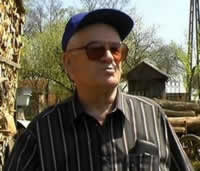
Moses RubinfeldMoses Rubinfeld In the middle of '70s in a magazine "Friendship" there
was an announcement which was published by Mr. Moses Rubinfeld, in which
he asked for a contact with the inhabitants of Rybotycze. He was probably
the only Jew from Rybotycze, who survived the extermination during the
war. One lady, who did not want to give her name, to do it on the quiet
, answered to his announcement inviting him to see the town where he was
born. With her husband, she helped him to fix all formalities - the invitation,
visa, and so on, to come here from the Soviet Union to Poland. Unfortunately,
Moses Rubinfeld did not find anybody from his relatives here. Since that
time, Rubinfeld with his family has been visiting them many times. They
became close friends. Unfortunately, we can give neither the surname nor
show the photo of that woman. She wished to remain anonymous because she
thinks that publicity destroys the real sense of a good deed. She, being
an orphan during the war, did it because of human feelings. Thanks to her
Mr Rubinfeld could return to Rybotycze, took up renovating the old Jewish
cemetery and gave the idea of this project, which we are carrying on. Maybe
if it had not been for her help we would not be here now.
The memory of the boy
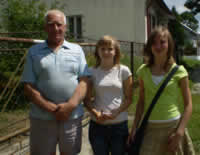
Mr. Marian Wilgucki, whose family house
neighboured with Jewish houses,
told us
many other interesting stories..Mr. Marian Wilgucki, whose
family house was next to Jewish houses, told us many other interesting
stories. Mr. Marian Wilgucki, whose house was next to many Jewish houses
and shops told us a tragic story of a young Jewish girl, which he has witnessed
as a young boy. Rybotycze's Jew, named Jejwach, who used to take care of
ritual Jewish baths - mykwa, had a beautiful 18 year old daughter. When
she found out that Jews were to be taken away she hid herself in a cellar,
behind stones. She spent there three days. Unfortunately, on the fourth
day, when she went out, a Ukrainian soldier saw her. Without anz hesitation
he shot her down. The father of Mr. Wilgucki was chosen to bury her. She
is buried in the cemetery in Rybotycze.
The treasure of Rybotycze.
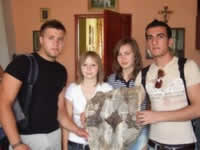
At first, the Polish and Israeli youth did no
realise what a treasure
they had In their
hands. 
The whole family of Mrs. Małgorzata
Kurkowa was always an honest and lokyal
friend of the Jewish socjety.At
first, Polish and Jewish youth did not realize what a treasure they had
in their hands.
The whole family of Ms. Małgorzata Kurkowa was always a faithful and loyal
friend of Jews In the house of Ms. Kurkowa we managed to take aphoto of
a piece of Tora that has survived.
When Germans, during World War II, told Jews to set fire to their holy
book, they refused. Germans, not being able to force them to do that, were
killing Jews, one after another. In the end, it was they who had to set
fire to the Tora. But it turned out, that not the whole book had been burnt.
Somebody took some pieces of it from ashes. Last year, Ms. Kurkowa 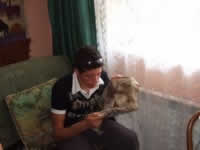
Our friend Alaa read and translated us
a piece of Tora.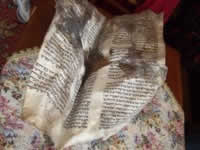
Despite the damages made by fire, water
and time, the piece of Tora has
surviwed
in a good condition. Our friend Alaa read and translated
a piece of
Tora to us. bought it to give it to Mr. Rubinfeld. This treasure is waiting
for him in her place. Because of the boys from Israel, who read the survived
piece of Tora, we found out which piece of Tora it is.
In spite of destructions made by fire,
water and time, the piece of Tora has survived in good condition. It turned
out, that the survived piece tells a story of the Egiptian captivity and
of leaving Egypt by Jews.
Cadyk - miracle-maker

The painting painted on the basis of
a black-white photo, on which there was
a synagogue in Rybotycze.Ms. Kurkowa told us an intersting story
about one of the rabbis from Rybotycze. Before the war, when in Rybotycze
were two synagogues, in one of them there was a Cadyk famous in the whole
surrounding area for his healing power. People who were in need used to
come to him from far-away territories. a married couple from Ms. Kurkowa's
family could not have children. They went to that Cadyk, and though they
were not Jews, the healing power of him made that in their family there
appeared a child.
Greek Catholic cemetery.
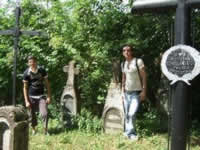

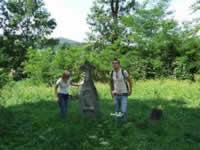
Catholic cemetery.
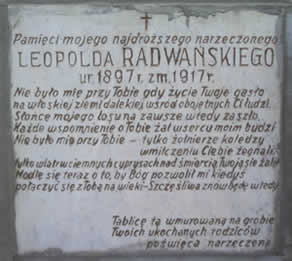
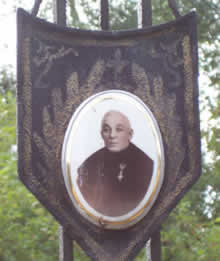
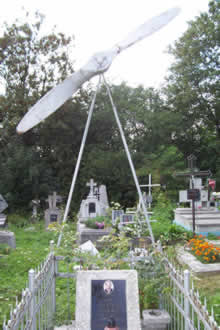

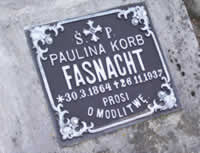
Kirkut
In 1785 Jews In Rybotycze had their own religion commune, and at the end of the 19th century a brick synagogue, a house in which they could pray, cheder, and a school. To kahał belonged the inhabitants of not far situated Wojtkowa. At the beginning of the19th century Cwi Elimelech Szapiro was the rabbi, he was the founder of the dynasty of Dynow, after him: Eleazer Szapiro (the son of Elimelech, the later cadyk in Łańcut), Samuel Szapiro (1831-1893), Józef Beniamin Reich (1834-1914), Cwi Elimelech Szapiro, (the later cadyk in Błażowa), Jozue Elimelech, (cadyk and rabbi), Mendel Maroles, The Jewish cemetery is situated 300 m from Rybotycze, on a hill, next to a road to Makowa, on this cemetery there are still 200 tombstones.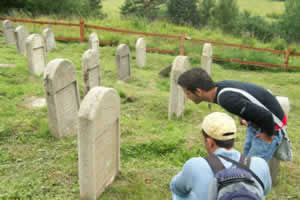
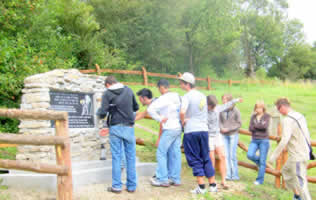
The obelisk which commemorates the tragedy of Jews from
Rybotycze, which was put up by Mr. Moses Rubinfeld's initiative. 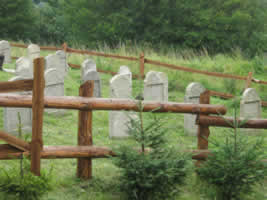
The fence of the cementry was put thanks to kindness
of the foresty management of Bircza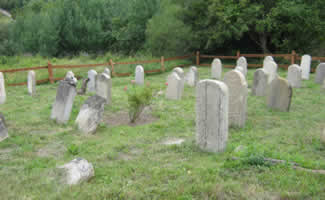
The school of iconic art in Rybotycze
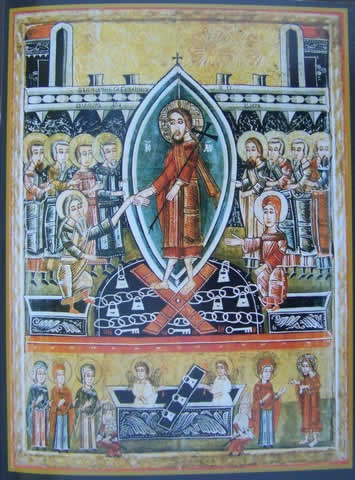
Descending to the abyss, Cewków, XVI c.
Rybotycze was the local centre of painting icones, it was started by monks from Posada Rybotycka's monastery. The first written mention of Prokop Popowicz from Dubrawka, who used to paint in Rybotycze ilustrations to Gospel, dates back to 1589. One can find icons from Rybotycze in Orthodox churches in the area of the whole Karpaty region, apart from Poland and Ukraine also in Slovakia and Romania. Many of them are now in museums in Sanok, Przemyśl, Cracow, Łańcut and Lvov.
Catholics of the Eastern rite.
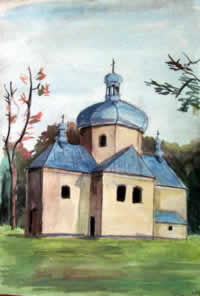
The painting made by Tomasz Król
- an old Orthodox church 
icon made in a traditional way by Tomasz Król A brick chuch which
does not exist any more and was built in 1775 , renovated in 1923. The
Greek Catholic parish in Rybotycze belonged to the Dobromilski's dekanat.
To this parish belonged also Orthodox churches in Kopyśń and Posada Rybotycka.
Posada Rybotycka

The Orthodox church in Posada Rybotycka Probably, in the middle
of 14th century there was built an Orthodox St. Onufry's monastery of Basilians
and next to it was made a hamlet, which was mentioned in the documents from 1367.
This brick, defensive Orthodox church is the oldest one from all other ones situated
in Poland (by 1692 Orthodox, then Greek Catholic). In 1921 in Posada Rybotycka
there were 98 houses and 602 inhabitants, 75 of them declared to be Polish. In
1945 those inhabitants were displaced to Ukraine. Nowadays, there are only few
buildings in Posada Rybotycka.
Famous people from Posada
Brothers Wasyłyk
The dean of the depertment of painting and icons in the Academy of Fine Arts in Lvov comes from Posada Rybotycka.
His brother is a Greek Catholic bishop in Lvov.